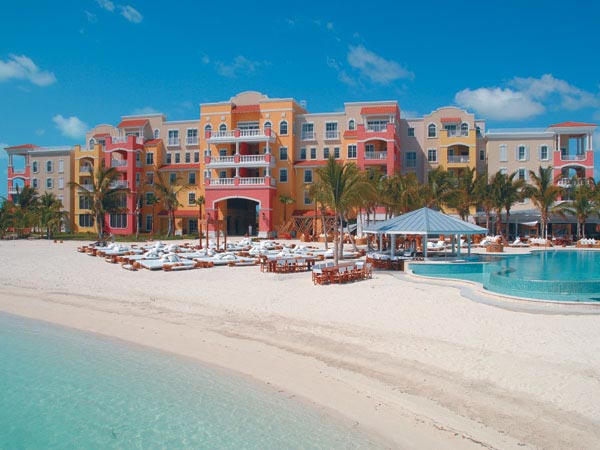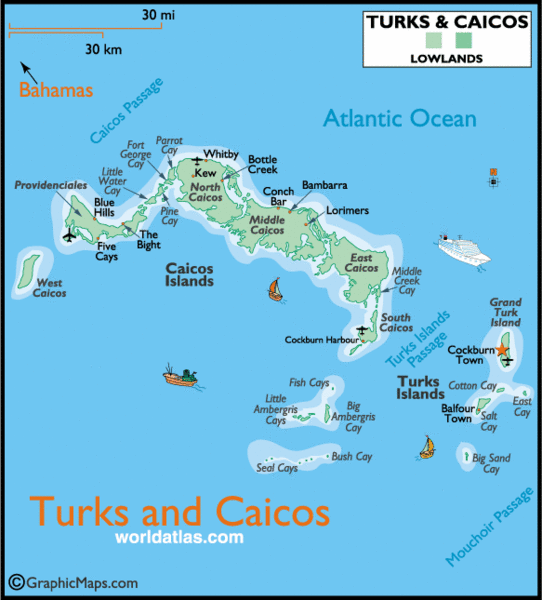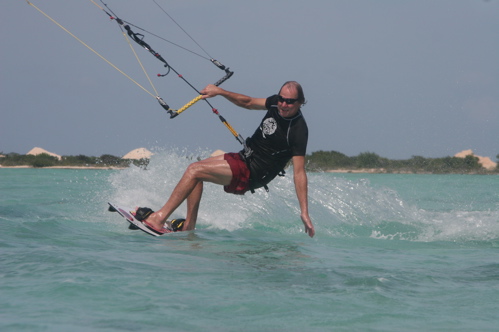The Caribbean Island of The Turks & Caicos
|
|
 The Turks and Caicos Islands are a British Overseas Territory consisting of two groups
of sub-tropical islands in the West Indies, the larger Caicos Islands and the smaller Turks
Islands, known for tourism and as an offshore financial centre. The Turks and Caicos Islands are a British Overseas Territory consisting of two groups
of sub-tropical islands in the West Indies, the larger Caicos Islands and the smaller Turks
Islands, known for tourism and as an offshore financial centre.
The Turks and Caicos Islands are situated about 600 miles (970 km) southeast of Miami in the
United States, and 50 miles (80 km) southeast of Mayaguana in the Bahamas, and have a total land area of 166 square miles (430
km2). The islands are geographically contiguous to the Bahamas, but are politically a separate
entity.
The islands have a total population of about 30,000, of whom approximately 22,500 live on
Providenciales in the Caicos Islands. Cockburn Town, pronounced KO-burn, is the capital, situated
on Grand Turk Island.
|
Turks & Caicos History
|
|

Early inhabitants of the islands were Amerindians, including the Arawak people, who were, over
the centuries, gradually replaced by the Caribs. The first documented European to sight the islands
was Spanish conquistador Juan Ponce de León, who did so in 1512. During the 16th, 17th and 18th
centuries, the islands passed from Spanish, to French, to British control, but none of the three
powers ever established any settlements.
For several decades around the turn of the 18th century they became popular pirate hideouts.
Bermudian salt collectors settled the Turk Islands around 1680. In 1765–1783 they were under French
occupation. After the American Revolution (1775–1783) many loyalists fled to Caribbean colonies,
including (in 1783) the first settlers on the Caicos Islands; cotton became an important crop
briefly. In 1799, both the Turks and the Caicos island groups were annexed by Britain as part of
the Bahamas.
In 1841 the Trouvadore, a Spanish ship engaged in the slave trade, wrecked off the coast of East
Caicos, one of the larger Caicos Islands. One hundred and ninety-two captive Africans survived the
sinking and made it to shore where, under British rule, the slave trade was illegal. These
survivors were apprenticed to trades for one year then settled mostly on Grand Turk Island. An 1878
letter documents the "Trouvadore Africans" and their descendants as constituting an essential part
of the "labouring population" on the islands. In 2004 marine archaeologists rediscovered a wreck,
called the "Black Rock Ship," that subsequent research has suggested may be that of the Trouvadore.
This suggestion was further supported when a marine archaeology expedition funded by NOAA in
November 2008 confirmed that the wreck comprises artifacts whose time of manufacture and style
support the association of this wreck with that of the Trouvadore. The wreckage has, however, not
been identified with absolute certainty.
In 1848, the Turks and Caicos were declared a separate colony under a council president. The
last incumbent was maintained in 1873 when the islands were made part of Jamaica colony; in 1894
the chief colonial official was restyled commissioner. In 1917, Canadian Prime Minister Robert
Borden suggested that the Turks and Caicos join Canada, but this suggestion was denied by British
Prime Minister David Lloyd George. The islands remained a dependency of Jamaica until 1959.
On 4 July 1959, the islands were again a separate colony, the last commissioner being restyled
administrator, but the governor of Jamaica remained the governor of the islands. Until 31 May 1962,
they were one of the constitutive parts of the Federation of the West Indies.
When Jamaica was granted independence from Britain
in August 1962, the Turks & Caicos Islands became a crown colony. From 1965, the governor of
the Bahamas was also governor of the Turks and Caicos
Islands and oversaw affairs for the islands. When the Bahamas gained independence in 1973, the
Turks and Caicos received their own governor (the last administrator was restyled). In 1974,
Canadian New Democratic Party MP Max Saltsman tried to use his Private Member's Bill to create
legislation to annex the islands to Canada, but it didn't pass in the Canadian House of
Commons.
The islands have had their own government headed by a chief minister since August 1976. In 1979,
independence was agreed upon in principle for 1982, but a change in government caused a policy
reversal, and they instead approached the Canadian government to discuss a possible union, but at
the time the Canadian Government was embroiled in a debate over free trade with the U.S., and
little attention was paid to the suggestion. In 2004 the Canadian province of Nova Scotia gave an
invite to join but Canada's government said they would look at the matter later. The islands'
political troubles in recent years have resulted in a rewritten constitution promulgated in
2006.
|
Turks & Caicos Geography
|
|

Geography
The two island groups are in the North Atlantic Ocean, southeast of the Bahamas, north of Hispaniola, and about 600 miles (970 km)
from Miami in the United States, at 21°45′N 71°35′W / 21.75°N 71.583°W / 21.75; -71.583. The
territory is geographically contiguous to the Bahamas, both comprising the Lucayan Archipelago, but
is politically a separate entity. The Caicos Islands are separated by the Caicos Passage from the
closest Bahamian islands, Mayaguana and Great Inagua.
The eight main islands and more than 20 smaller islands have a total land area of 238.0 square
miles (616.4 km2),[3] primarily of low, flat limestone with extensive marshes and mangrove swamps
and 230 miles (370 km) of beach front. The weather is
usually sunny and relatively dry, but suffers frequent hurricanes. The islands have limited natural
fresh water resources; private cisterns collect rainwater for drinking. The primary natural
resources are spiny lobster, conch and other shellfish.
The two distinct island groups are separated by the Turks Passage.
Turks Islands
The Turks Islands, separated
from the Caicos Islands by Turks Island Passage (more than 7,200 ft/2,200 m deep), are a chain that
stretches north–south. The total area is 10.3 square miles (26.7 km2), with an estimated population
of 5,753. There are two main islands, which are the only inhabited ones of the group:
* Grand Turk (with the capital of the territory, population 5,567)
* Salt Cay (population 186)
Together with nearby islands, all on Turks Bank, those two main islands form the two of the six
administrative districts of the territory that fall within the Turks Islands. Turks Bank has a
total area of about 175 square miles (450 km2).
|
|
Mouchoir Bank
16 miles (26 km) east of the Turks Islands and separated from them by Mouchoir Passage is Mouchoir
Bank. Although it is submerged with a least depth of 6 feet (1.8 m), and has no emergent cays or
islets, it is part of the Turks and Caicos Islands and falls within its Exclusive Economic Zone.
Mouchoir Bank measures 370 square miles (960 km2) in area. Two banks further east, Silver Bank and
Navidad Bank, are geographically a continuation, but belong politically to the Dominican
Republic
Administrative divisions
The Turks and Caicos Islands are divided into six administrative districts (two in the Turks
Islands and four in the Caicos Islands), headed by district commissioners. For the House of
Assembly, the Turks and Caicos Islands are divided in to 15 electoral districts (four in the Turks
Islands and eleven in the Caicos Islands).
Language
The official language of the
islands is English and the population also speaks Turks and Caicos Islands dialect which is similar
to Bahamian dialect.
Economy
In 2006, GDP contributions were as follows: Hotels & Restaurants 23.27%, Financial Services
29.64%, Construction 48.71%, Wholesale & Retail Trade 20.89% and Health & Social Work
10.83%.[clarification needed] Most capital goods and food for domestic consumption are
imported.
In 2006, major sources of government revenue included Import Duties (36.51%), Stamp Duties from
Property Transactions (19.79%), Work Permits and Residency Fees (8.93%) and Accommodation Tax
(8.84%). The territory's gross domestic product as of late 2006 is approximately US$722 million
(per capita $17,112), with an inflation rate of 3.7%.
The unemployment rate in 2007 was 5.4%. In 2006–2007, the territory took in revenues of $202.5
million against expenditures of $199.5 million. In 1995, the island received economic aid worth
$5.7 million. The territory's currency is the United States dollar, with a few government fines
(such as airport infractions) being payable in pounds sterling. Most commemorative coin issues are
denominated in crowns.
The primary agricultural products include limited amounts of maize, beans, cassava (tapioca) and
citrus fruits. Fish and conch are the only significant export, with some $169.2 million of lobster,
dried and fresh conch, and conch shells exported in 2000, primarily to the United States and the
United Kingdom. In recent years, however, the catch has been declining. The territory used to be an
important trans-shipment point for South American narcotics destined for the United States, but due
to the ongoing pressure of a combined American, Bahamian and Turks and Caicos effort this trade
been greatly reduced.
The islands import food and beverages, tobacco, clothing, manufacture and construction
materials, primarily from the United States and the United Kingdom. Imports totalled $581 million
in 2007.
The islands produce and consume about 5 GWh of electricity, per year, all of which comes from
fossil fuels.
|
Tourism in the Turks & Caicos
|
|

The United States was the leading source of
tourists in 1996, accounting for more than half of the 87,000 visitors; another major source
of tourists is Canada. Tourist arrivals had risen to 264,887 in 2007
The government is pursuing a two-prong strategy to increase tourism. Upscale resorts are aimed at
the wealthy, while a large new cruise ship port and recreation centre has been built for the masses
visiting Grand Turk. Turks and Caicos Islands have one of the longest coral reefs in the world,
making it a premier diving destination.
Several Hollywood stars have built homes in the Turks and Caicos, including Dick Clark and Bruce
Willis. Ben Affleck and Jennifer Garner were married on Parrot Cay. Actress Eva Longoria and her
husband Tony Parker went to the islands for their honeymoon in July 2007 and High School Musical
actors Zac Efron and Vanessa Hudgens went for a vacation there. Motivational speaker Eric Edmeades'
official website[24] indicates that he resides in Providenciales.
On 31 January 2008, the Turks and Caicos Government signed a letter of intent with the Indy
Racing League to host the Indy Turks and Caicos Grand Prix, slated for February 2009. A new race
track will be constructed in Blue Hills, Providenciales to host the event The islands' only 18-hole
championship golf course, Provo Golf Club was opened in 1992. The course hosted the Caribbean
Amateur Golf Championship in 1999, and is due to do so again in 2009.
In an apparent effort to boost tourism during the Caribbean low season of late summer, the Turks and Caicos
Tourist Board has organized and hosted an annual series of concerts called the Turks & Caicos
Music and Cultural Festival since summer of 2003. Held in a temporary bandshell at The Turtle Cove
Marina in The Bight on Providenciales, this festival lasts about a week and has featured several
notable international recording artists such as Lionel Richie, LL Cool J, Anita Baker, Billy Ocean,
Alicia Keys, John Legend, Kenny Rogers, Michael Bolton, Ludacris, Chaka Khan, and Boyz II Men. More
than 10,000 people attend annually.
Transportation
Providenciales International Airport is the main entry point for the Turks and Caicos Islands.
Altogether, there are seven airports, located on each of the inhabited islands. Five have paved
runways (three of which are approximately 2000 metres long and one is approximately 1000 metres
long), and the remaining two have unpaved runways (one of which is approximately 1000 metres long
and the other is significantly shorter).
The islands have 121 kilometres of highway, 24 km paved and 97 km unpaved.
The territory's main international ports and harbours are on Grand Turk and Providenciales.
The islands have no significant railways.
Turks and Caicos Islands
The Turks and Caicos Islands are two groups of islands in the North Atlantic Ocean, southeast of
the Bahamas.
Even though you only boarded the plane in Miami, Florida a scant hour before, the moment you step
off the plane, you know you are in a different world. The tropical breeze hits you as you step onto
the tarmac, and you start looking forward to the incredible scuba diving that awaits. Although
definitely not one of the prettiest (at least above water) of the islands, it has its own charms
that come from being a mostly undiscovered tourist destination.
Regions
* Caicos Islands
* Providenciales
* North Caicos
* Middle Caicos
* East Caicos
* South Caicos
* West Caicos
* Grand Turk
* Turks Islands
Cities
* Cockburn Town -
capital.
* Cockburn Harbour
* Bottle Creek
* Blue Hills
{Credit} http://en.wikipedia.org
|
Turks and Caicos flag and Coat of Arms
|
|
|

|
 |
|
Description
The current flag of the Turks and Caicos was officially adopted in 1968.
As an overseas territory of the United Kingdom, the islands fly the (UK) flag. The
coat of arms shield (shown) displays a conch shell and a crayfish representing the
local fishing industry, and a flowering cactus representing local flora.
|
The Coat of Arms
of the Turks and Caicos Islands were granted in 1965.
The Arms consist of a shield bearing a conch shell, lobster, and cactus on a yellow
background. The dexter and sinister supporters are flamingos. The crest is a pelican
between two sisal plants representing connection to the rope industry.
The shield from the arms feature on the Flag of the Turks and Caicos Islands, and on
the defaced Union Flag of the
Governor |
|
Getting Married in the Turks & Caicos Islands
|
|

Turks & Caicos Marriage
Requirements
The information below outlines the marriage requirements for getting married in Turks &
Caicos
To get married in Turks and Caicos there is a waiting period of only 24 hours.
Documents required
* passport
* birth certificate
* proof of single status: decree absolute (or death cert) or a sworn affidavit
of singledom
* in cases of name change you will need the Deed Poll or Adoption documents
* if under the age of 21 then notarized parental consent.
* The parties must not be within the prohibited degree of relationships to each
other.
* Letter stating both parties occupations, marital status, age as of last
birthday, present address of residence and fathers full name.
* For church weddings most Ministers require proof of membership.
The marriage must be solemnized by a registrar of Marriage Officer (usually the Registrar
General for Special Licenses) who is entitled to payment of reasonable traveling expenses if the
marriage takes place other than at his usual place of business.
License fee is US$50.00. Only original documents should be presented and must be translated into
English where they are not already.
Marriage licences may take 2 or 3 days to obtain.
Registrars Offices
The registrar's office should be contacted for specific rules regarding planning your
destination or beach wedding in Turks & Caicos. They will also provide information regarding
marriage licenses and marriage certificates.
Lenora Missick
Registrar of Marriages
Tel: 649 941 5123
{Credit} http://www.islandbrides.com
|
|